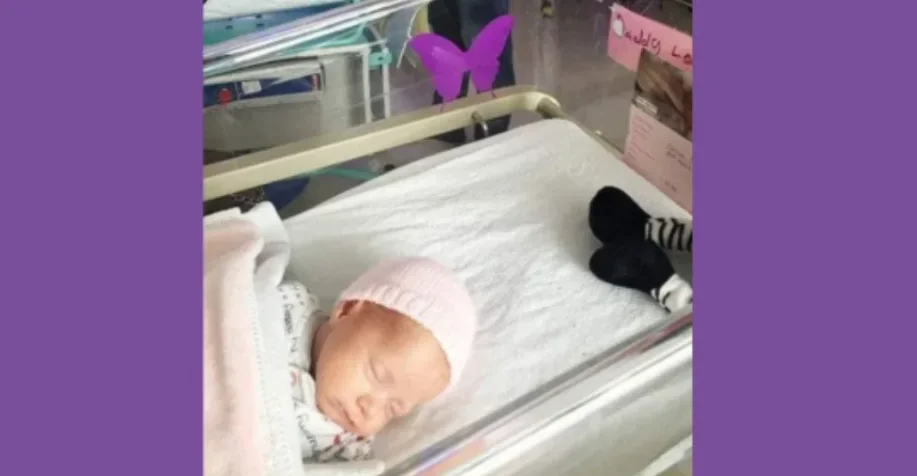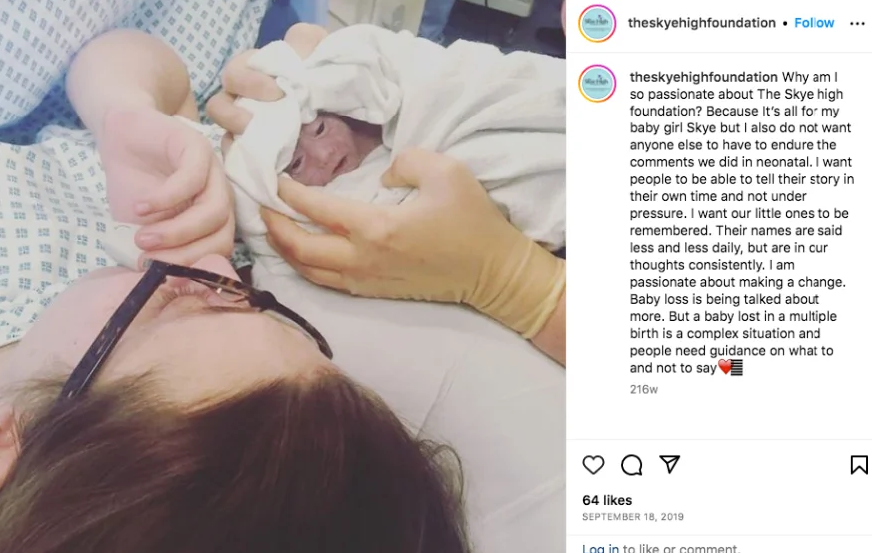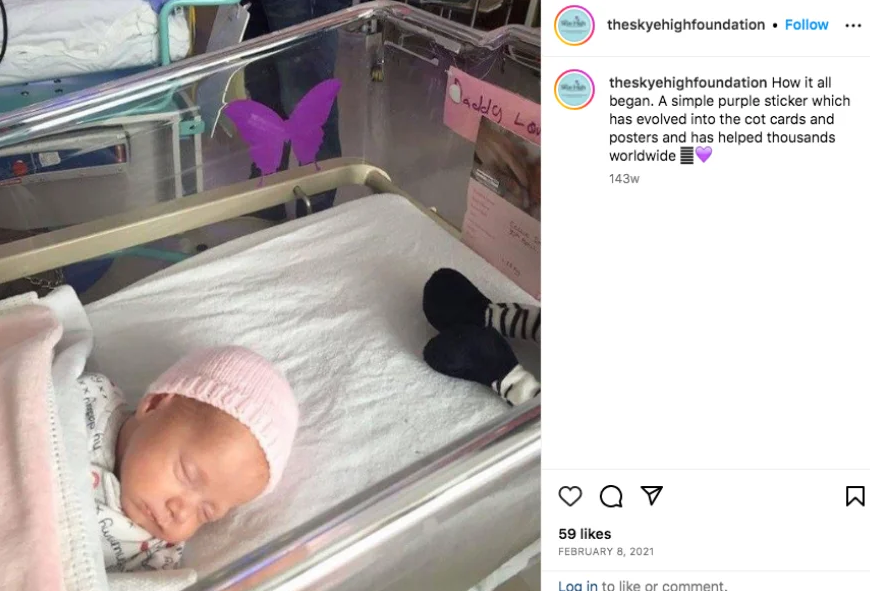
When Millie Smith and Lewis Cann found out they were expecting a baby, they were overjoyed. As there was a history of twins in Millie’s family, she had a strong feeling that she was going to give birth to two little ones, and her instincts were right. The ultrasound confirmed that she was indeed expecting twins, but the doctors told them that one of the babies had a very small chance of survival.
ragically, one of their daughters was born at 30 weeks with anencephaly, a serious condition that affects the development of the brain and spinal cord. They learned that their precious baby had only moments or hours to live.
Knowing this, Millie and Lewis wanted to give her a name before they said goodbye. They chose the name Skye. Millie explained: “We felt she needed a name before she arrived. Knowing she wouldn’t be with us for long, I wanted her to have a name in those fleeting moments”.
The name “Skye” symbolized a connection to a place they could always remember when they looked up to the sky. “We held Skye close as she died. It was the most heartbreaking moment of our lives, but I’m proud that she fought to spend that time with us.” Skye only lived for three hours, a brief time filled with love while her parents cherished her beauty and presence.

After her death, Millie and Lewis were supported by a “bereavement midwife” and given access to a “Daisy Room”, a special room where parents could spend time with their baby before and after death. However, after Skye was gone, her memory seemed to fade; no one spoke of her, leaving Millie feeling like her daughter had never existed, which made her angry.
“Most of the nurses knew what had happened, but as the weeks went by, people stopped mentioning Skye. Other families around me had no idea about our loss”, Millie recalls.

While her other daughter, Callie, was still in the NICU, another mother who knew nothing about Millie’s situation remarked how lucky she was not to have twins. “None of the other parents knew about Skye, and that innocent comment almost broke me. I left the room in tears but didn’t have the heart to explain”, Millie said. “A simple sticker could have prevented this.”
This experience inspired Millie to design a sticker for incubators to mark the loss of one or more babies in a multiple birth. She chose butterflies to symbolise the ‘flown away’ babies and used the colour purple, which is suitable for any gender.
From this idea grew the Skye High Foundation, which promotes the Purple Butterflies initiative and helps raise awareness in hospitals around the world. The foundation also offers a range of purple butterfly merchandise.
“Although I can’t prevent these situations from occurring, I believe the more support we can provide through initiatives like the stickers, the better it will be for others who suffer this loss. It’s an incredibly tough journey”, said Millie. Today, her surviving daughter Callie is seven years old.
Woman Follows Little Boy Who Takes Leftovers from Her Restaurant Every Day

Alice suspected that the boy who regularly gathered leftovers from her restaurant was hiding something, so she decided to follow him one day.
But what she found along the road astonished her.
“You got lucky, kid. We have plenty of leftovers today, and you can take all of it home,” Steve said. He was the head chef at Alice’s restaurant and regularly saved the leftovers for Christopher, a small youngster who frequented their establishment for food.
“Oh really? Is it actually so much food? Do I have enough to share with my friends?” Christopher’s eyes brightened up.
Christopher was overjoyed upon receiving the food packs. He thanked Steve with a big smile, waved goodbye, and walked away cheerfully.

Alice, on the other hand, had no idea this was standard procedure at her restaurant until she noticed Christopher leave one night. She wasn’t certain, though, that he would eat leftovers to keep his tummy full.
She waited for him to return for a few days before seeing him at the restaurant on the third day. “Hi, there. Are you here for the leftovers?” she inquired, softly.
“Yes!” Chris responded pleasantly. “Can you please call the cook? He must have kept those packets for me.”
Alice offered him a kind smile.
“Well, there’s no need for that. I’ve prepared some fresh food for you so that you don’t eat the leftovers. By the way, what’s your name?”
“My full name is Christopher, but you may call me Chris.”
“So, why don’t you eat at home, Chris?” Alice asked. “Is your mom sick?”
“Well, actually … I live at an orphanage, and they don’t feed me well. Every time I come here, your employees help me. I’m grateful to you for that. Anyway, I’ll leave now,”

Alice had a sneaky hunch the boy had been concealing something all along. So, that day, she decided to follow him. She was astonished by what she saw next.
Instead of visiting an orphanage, Chris went to a residence, placed the food bag on the porch, and rushed away. Soon, an older woman emerged; she looked about in confusion, accepted the bag, and returned inside.
Alice was ready to knock on the door and ask that lady who she was and how she knew Christopher when she received an urgent call from the restaurant and had to leave.
When Christopher returned to the restaurant the following day, she was already there to wait for him.
“I’m sorry, I lied to you,” Chris instantly admitted. “But I’ve been taking food for my granny. She’s the only family I have now.”
“When my parents pa:ss:ed away, my grandmother didn’t get custody because she wasn’t financially stable. She can’t even afford food, so every day, I collect food from here and drop it off at her house.”

So, that day, she went to see his grandmother and told her everything. Christopher’s grandma, Edith, was taken aback when she realized it was her grandson who had been leaving food boxes on her porch all along.
That day, Alice went to the orphanage where Christopher was staying and applied for custody. Fortunately, the formalities were completed swiftly, allowing Christopher to return to his grandmother’s home.

Edith grasped Alice’s hands in her own. “I can’t make up for it, but you’re welcome to come to see us whenever you want. After all, you’re like family to us.”
“Oh, in that case, I have something to offer you…”
Edith had expected Alice to offer her a position in the restaurant, but when she learned what it was, she burst into tears again.
“I know it might be a bit too much to ask for, but ever since I lost my parents, I have had no one to look after me,” Alice said. “So, I’m looking for someone who will love me like a mother. I’m hoping you’ll accept the position. As far as Chris’ education is concerned, it’s my responsibility because I’m his guardian.”
“Of course, honey,” Edith replied as he embraced her. “I’ll never be able to repay your generosity. You literally appeared in our lives like an angel.”
“You don’t need to thank me,” Alice said. “I have a family now because of you, and I think that’s the greatest wealth I can ever have.”



Leave a Reply